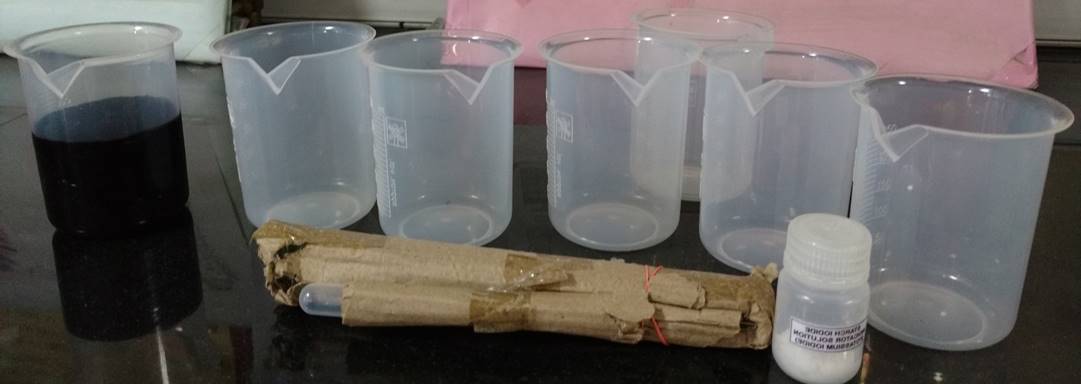
Horrock’s apparatus is used for estimating the dose of bleaching powder needed to disinfect 455 Liters of water
It is used mostly while disinfecting the water in a well
Contents of ‘Horrock’s Apparatus’
• 6 white cups, each of 200 ml capacity
• One black cup with a circular mark on the inside
• 2 metal spoons (each holds 2g of bleaching powder when filled up to the brim)
• 7 glass stirring rods
• One special pipette
• Two droppers
• Starch - iodide indicator solution
• Instruction folder
Steps in Estimating the Required Dosage of Bleaching Powder for disinfecting water
1. One level spoonful (2g) of bleaching powder is placed in the black cup and made into a thin paste with a little water
More water is added to the paste to bring up the volume up to the circular mark
The solution thus prepared is the ‘Chlorine Stock Solution’
2. The six white cups are filled with the water to be tested
3. Using the pipette provided with the apparatus, add one drop of the stock solution to the first cup, two drops to the second cup, three drops to the third cup, and so on till adding six drops to the sixth cup.
4. Stir the water in the cups; use a separate rod for each cup
5. Wait for half an hour
6. Add three drops of starch-iodide indicator to each of the white cups
7. Development of blue color indicates the presence of free residual chlorine.
8. The first cup which develops this color gives an estimate of the amount of bleaching powder needed to disinfect 455 L of the sample water.
If first cup develops blue colour: 1 spoonful (i.e. 2gm) of bleaching powder would suffice for 455 L of water
If the second cup develops blue colour: 2 spoonfuls (4 gm) of bleaching powder for 455 L of water
Third cup develops blue colour: 3 spoons (6 gm), so on till the sixth cup when it means 6 spoons (12 gm) of bleaching powder is needed for 455 liter of water
If none of the cups develop a blue colour, this means that the chlorine demand of the water is very high and it is better to use some method of clearing the water prior to chlorinating it
OT and OTA test: http://www.ihatepsm.com/blog/orthotolidine-ot-test-and-orthotolidine-%E2...
Membrane processes in water purification: http://www.ihatepsm.com/blog/membrane-processes-treatment-drinking-water
Super Chlorination and Break Point Chlorination: http://www.ihatepsm.com/blog/super-chlorination-and-break-point-chlorina...
Slow sand filter: http://www.ihatepsm.com/blog/slow-sand-filter-biological-filter
Rapid sand filter: http://www.ihatepsm.com/blog/rapid-sand-filter-mechanical-filter
Purification of water at a large scale: http://www.ihatepsm.com/blog/water-purification-large-scale-water-supply
Criteria for a Chemical to be Suitable as Water Disinfectant in Water Supplies: http://www.ihatepsm.com/blog/criteria-chemical-be-suitable-water-disinfe...
Water Supplies Disinfection with Chlorination: http://www.ihatepsm.com/blog/water-supplies-disinfection-chlorination
Principles of Chlorination: http://www.ihatepsm.com/blog/principles-chlorination
Methods of Chlorination in Water Supplies: http://www.ihatepsm.com/blog/methods-chlorination-water-supplies
Horrock's Apparatus: http://www.ihatepsm.com/blog/horrock%E2%80%99s-apparatus
Disinfection of well during emergency: http://www.ihatepsm.com/blog/disinfection-wells-during-emergency-%E2%80%...
Double Pot method: http://www.ihatepsm.com/blog/disinfection-wells-during-emergency-%E2%80%...
Disinfection of Wells: http://www.ihatepsm.com/blog/disinfection-wells
OT and OTA test: http://www.ihatepsm.com/blog/ot-and-ota-test
Domestic or Household Purification of Water: http://www.ihatepsm.com/blog/domestic-or-household-purification-water
